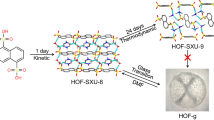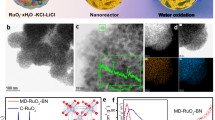Abstract
Various classes of compounds, including hydroquinone, urea, cyclodextrin and montmorillonite, can act as host compounds having several types of inclusion spaces, such as three-dimensional cages, parallel channels and layers1. Despite the variety of host compounds, however, little attention has been paid to the possible complexation of two or more of different kind host components: all inclusion compounds so far reported2 use a single component as the host structure. We have now prepared, for the first time, a host compound consisting of two components, one layered and one single channel-like, in which dimers of 1:1 complex of Cu(II) with mono-(6-β-aminoethylamino-6-deoxy)-β-cyclodextrin (CDen) are formed in a stable condition and are closely packed between the silicate layers of montmorillonite, with their opening faces parallel to the interlayer surface. This compound is unique because the cyclodextrin which it takes up as a guest component can also act as host for many substances. In view of the enzymatic function of cyclodextrins, this class of compounds seems promising for use as an immobilized artificial enzyme and in models of membrane enzymes.
This is a preview of subscription content, access via your institution
Access options
Subscribe to this journal
Receive 51 print issues and online access
$199.00 per year
only $3.90 per issue
Buy this article
- Purchase on Springer Link
- Instant access to full article PDF
Prices may be subject to local taxes which are calculated during checkout
Similar content being viewed by others
References
Takemoto, K. in Chemistry of Inclusion Compounds Ch. 2 (Tokyo-Kagaku-Dojin, Tokyo, 1969).
Saenger, W. Angew. Chem. 19, 344–362 (1980).
Bender, M. L. & Komiyama, M. Cyclodextrin Chemistry (Springer, Berlin, 1978).
Theng, B. K. G. in The Chemistry of Clay-Organic Reactions, Ch. 1 (Adam-Hilger, London, 1974).
Matsui, Y., Yokoi, T. & Mochida, K. Chem. Lett. 1037–1040 (1976).
Kijima, T., Kobayashi, M. & Matsui, Y. 3rd int. Symp. on Clathrate Compounds and Molecular Inclusion Phenomena—2nd int. Symp. on Cyclodextrins, Tokyo (1984).
Theng, B. K. G. in The Chemistry of Clay-Organic Reactions, 10 (Adam-Hilger, London, 19724).
Greenland, D. J., Laby, R. H. & Quirk, J. P. Trans. Faraday Soc. 58, 829–841 (1962).
Hingerty, B. & Saenger, W. J. Am. chem. Soc. 98, 3357–3365 (1976).
Fugiwara, T. J. cryst. Soc. Jap. 24, 54–64 (1982).
Wells, A. F. in Structural Inorganic Chemistry, 4th edn 301–304 (Clarendon, Oxford, 1975).
Wyckoff, R. W. G. in Crystal Structures 2nd edn Vol. 5, 344–345 (Interscience, New York, 1966).
Pauling, L. in The Nature of Chemical Bond 3rd edn, Ch. 7 (Cornell University Press, New York, 1960).
Author information
Authors and Affiliations
Rights and permissions
About this article
Cite this article
Kijima, T., Tanaka, J., Goto, M. et al. A complex of copper (II)-montmorillonite with a modified cyclodextrin. Nature 310, 45–47 (1984). https://doi.org/10.1038/310045a0
Received:
Accepted:
Issue Date:
DOI: https://doi.org/10.1038/310045a0
This article is cited by
-
Inclusion of poly-aromatic hydrocarbon (PAH) molecules in a functionalized layered double hydroxide
Journal of Chemical Sciences (2006)
-
Inclusion behaviour of benzoic acid towards intercalates of ?- and ?-zirconium hydrogen phosphates with 2-aminopropylamino-substituted ?-cyclodextrin
Journal of Inclusion Phenomena and Molecular Recognition in Chemistry (1990)
-
Pillarization of lithium hectorite with metal complexes bearing large chelate ligands
Journal of Materials Science Letters (1989)
-
Complexes of Na-, Ca-, and Zn-montmorillonites with an aminated cyclodextrin
Journal of Inclusion Phenomena (1987)
-
A new type of host compound consisting of α-zirconium phosphate and an animated cyclodextrin
Nature (1986)
Comments
By submitting a comment you agree to abide by our Terms and Community Guidelines. If you find something abusive or that does not comply with our terms or guidelines please flag it as inappropriate.



